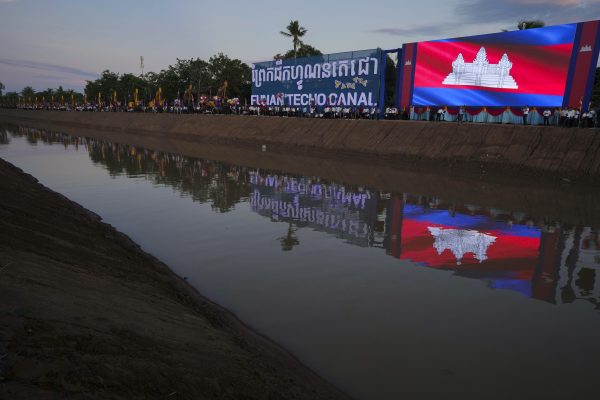Summary by Geopolist | Istanbul Center for Geopolitics:
Overview
Cambodia is developing the Funan Techo Canal, a large-scale infrastructure project designed to connect the Gulf of Thailand with the Mekong River. This ambitious project aims to transform Cambodia into a key maritime and logistical hub in Southeast Asia. However, the canal has significant geopolitical implications involving regional power dynamics and international interests.
Purpose and Scope
- Economic Goals: The Funan Techo Canal is intended to boost Cambodia’s economic growth by facilitating maritime trade. It will provide a direct maritime route from the Gulf of Thailand to the Mekong River, bypassing the congested Strait of Malacca.
- Infrastructure: The canal will be approximately 190 kilometers long and 50 meters wide. It is expected to accommodate large ships, enhancing Cambodia’s shipping and trade capabilities.
Regional and Global Implications
- Strategic Importance: The canal could reshape regional shipping routes, potentially diminishing the strategic significance of the Strait of Malacca, which is a crucial chokepoint for global maritime traffic.
- Economic Impact: By improving access to the Mekong River, the canal could enhance trade for Cambodia and its landlocked neighbors, like Laos and Thailand, boosting regional economic integration.
Geopolitical Tensions
- China’s Role: China has been heavily involved in the canal’s development, providing funding and expertise. This deepens China’s influence in Cambodia and the broader region, aligning with its Belt and Road Initiative (BRI) goals.
- U.S. and Western Concerns: The United States and other Western nations express concerns about the canal’s potential military and strategic uses. They worry about increased Chinese control over critical maritime routes and the potential for military installations or dual-use infrastructure.
- Vietnam’s Position: Vietnam is particularly concerned about the canal’s impact on its strategic interests, given its historical and ongoing rivalry with China. The canal’s development may influence regional power balances and affect Vietnam’s own strategic calculations.
Environmental and Social Concerns
- Environmental Impact: The canal’s construction poses risks to the Mekong River ecosystem and local communities. There are concerns about potential ecological damage and displacement of local populations.
- Social Implications: The project may also lead to significant changes in local land use and economic conditions, affecting communities along the canal route.
Current Status and Future Prospects
- Construction Progress: As of the article’s publication, construction is ongoing, but the project’s future is subject to various challenges, including financial, environmental, and political factors.
- Strategic Reactions: The canal’s development will continue to be monitored closely by regional and global powers, influencing diplomatic and economic strategies in Southeast Asia.
Conclusion
The Funan Techo Canal represents a significant infrastructure development with the potential to alter regional trade dynamics and geopolitical alignments in Southeast Asia. Its success will depend on how Cambodia navigates the complex web of regional interests and challenges associated with such a high-stakes project.
Read more below.
Cambodia has been in dire need of, and reliant on, external support for national development. But what is worrisome for neighboring countries and a range of concerned parties, including the United States and its allies, is the lack of clarity in its policies, mostly supported by China’s Belt and Road Initiative (BRI), that have potential implications for both regional stability and environmental sustainability.
The Funan Techo Canal project is no exception. As the artificial waterway project begins, this article builds on the previous work of other experts to analyze the project’s potential security implications for both Cambodia and the Association of Southeast Asian Nations (ASEAN). Examining the geopolitics of the canal sheds new light on areas in need of action and highlights a need for political trust-building and collective security of all ASEAN countries.
What Is the Funan Techo Canal Really For?
The China-backed Funan Techo Canal project has triggered public discourse about the potential security risks for Cambodia’s neighbors and Southeast Asia as a whole. Their concerns more or less stand to reason if one scrutinizes the complicated China-Cambodia-Vietnam relationship, the encroachment of what some called “Chinese neocolonialism,” and the rise of China’s People’s Liberation Army overseas, often in line with controversial BRI-funded infrastructure projects.
However, the canal alone does not imply nor pose a security threat to Vietnam. We agree with David Hutt’s recent conclusion that the canal itself has minimal to no military implications.
So, how can the geopolitics of the Funan Techo Canal best be interpreted?
Recent analysis suggests that the canal project will produce minimal economic returns. However, the importance of Funan Techo Canal lies beyond navigation. It is probably more aimed at mining, agricultural, and industrial modernization in southern Cambodia, the location of the China-backed Ream Naval Base and Chinese economic enclaves.
Generous loans under the BRI framework have created a geopolitical order that has reestablished China’s dominance in mainland Southeast Asia. Although economic achievements in terms of infrastructure development and economic growth have been highlighted by loan-recipient governments, the issues associated with the BRI are diverse and widely noted, including environmental degradation and resource depletion.
Politically, BRI-backed infrastructure projects that have the potential to expand China’s strategic and military reach can be found in Laos, Sri Lanka, Djibouti, and many other geopolitically important regions across Eurasia and Africa. In Cambodia particularly, China has invested heavily in the country to expand the reach of its soft power and diplomatic influence, ultimately underpinning its interests and presence.
When it comes to the Funan Techo Canal, if one considers the possibility of China having an exclusive military presence in Ream, then the economic benefits from such an arrangement become clear. This is a win-win deal for both countries.
For Cambodia, China’s generous aid programs and ambitious infrastructure development projects – including the modernization of Ream, highway systems, special economic zones, and now the construction of Funan Techo Canal – matter for the legitimacy of the country’s nepotistic government. Economically, advancing ambitious infrastructure projects is a favored strategy for the new government in Phnom Penh to consolidate its control and for Hun Sen’s son and his political allies’ children to establish their own status.
While these costly projects are believed to bring with them increasing risk of a governmental debt crisis, in the short-term they help reduce the unemployment crisis, stimulate national economic growth, and foster exports to Chinese markets. The artificial canal can be seen as part of the government’s new policy for Cambodia to become one of the world’s top ten agricultural economies by 2030.
Cambodia’s southeastern provinces are home to mineral resources important for mining and industrial activities, including the untapped oil and mineral reserves in Kampot, Takeo, and the Cambodian continental shelf. As China’s thirst for minerals, agricultural commodities, and timber from Cambodia increases, deals to build bigger roads and waterways to move natural resources from interior areas to coastal ports for export are a top priority.
By supporting the construction of Funan Techo, China will taken a critical step in the effort to convert Cambodia to its values. Just like the U.S. has in Japan, the People’s Liberation Army Navy (PLAN) needs long-term overseas outposts with as much localized and low-cost support as possible to secure its military logistics supply and stable overseas operations. The 2019 Chinese Defense White Paper confirmed this.
Cambodia’s southern coastal region stands to be the best fit as it encircles the whole Gulf of Thailand, enabling the PLAN to oversee neighboring commercially and militarily important ports in Thailand, Malaysia, and southern Vietnam. More importantly, Cambodia’s southern coast is close to the international shipping lanes and the oil-rich continental shelf between Vietnam and Indonesia, part of which falls into China’s self-defined “U-shaped” claim of maritime sovereignty in the South China Sea.
Early evidence reveals that the Funan Techo Canal is only phase one of an ambitious plan. Urbanization, agricultural modernization, mining activities, and infrastructure investment, including the construction of a deep seaport in Kep, will follow the canal, which will likely make way for Chinese-backed economic enclaves and military logistic supporting nodes in southern Cambodia.
From a strategic standpoint, if those development hubs were to be realized, this will give the PLAN perfect access to Ream Naval Base and to localized military supply chains and resources, e.g. local food supply and military supporting industries. This, in turn, would essentially translate as a unique advance for China’s alleged de facto military outpost in the Gulf of Thailand. (Cambodia has strenuously denied that Ream will function as an overseas base for the PLAN, but satellite images revealed that two Chinese warships were docked in the port for over five months from December 2023 to May of this year.)
Strategically, the economic footprint and military presence of China in Cambodia, especially in areas bordering Thailand and Vietnam, provide Phnom Penh with security protection and military modernization, and thus a more powerful position vis-à-vis its neighbors. The Funan Techo Canal, therefore, serves as a strategic backbone for military and economy-driven cooperation initiatives between both sides. This is more likely as it does not necessarily violate the Article 53 of Cambodia’s Constitution.
Potential Security Implications
Regional and local experts have voiced concerns over the possible irreparable impacts the Funan Techo Canal could have on local ecosystems and millions of people in both Cambodia and Vietnamese border provinces. For Vietnam, the poor design and mismanagement of project could exacerbate the existing water crisis in its fragile Mekong Delta.
“The region is already suffering the consequences of a legacy of poor local planning, upstream dam impacts, and climate change; however, it is difficult to specifically assign causality to the degree to which these factors impact the delta,” claimed the Stimson Center’s Brian Eyler. Yet, he believes that the impacts delivered by the Funan Techo Canal will be much easier to quantify and evaluate.
Vietnamese experts estimate that, in the worst-case scenario – i.e. if the canal is intended for dry season irrigation use – the canal-induced irrigation systems would diverst some 30-50 percent of the Mekong water in the dry season.
If the canal was “weaponized” by diverting water from the Mekong river to coastal estuaries, as some analysts worry, this could definitely put Vietnam’s food and water security at extreme risk, giving Phnom Penh considerable leverage over its neighbor.
Geopolitically, the canal, with its potential to foster Chinese-backed economic enclaves and military installations near Vietnam’s southwestern border, poses a foreseeable challenge to Vietnam’s national security.
A few decades ago, the two neighboring countries experienced significant conflict over the Chinese-backed Khmer Rouge’s raids into Vietnam, which prompted Vietnam to invade Cambodia and overthrow the regime in early 1979, and China’s subsequent invasion of Vietnam. Both governments are keen to avoid repeating this tragic history. However, Vietnam remains cautious, as a Cambodia with closer ties to China may not always align with Vietnam’s interests.
With recent tensions along the Cambodia-Vietnam border and unresolved issues regarding maritime demarcation in “historical waters,” nationalistic sentiments are rising in Cambodia. The construction of the Funan Techo Canal could potentially undermine political trust if it facilitates perceived Chinese encroachment near the Vietnamese border or causes significant transboundary impacts in the Mekong Delta.
“I’m not sure how seriously we should take Vietnam’s concerns about the canal allowing Chinese ships to range [Ho Chi Minh City] and other parts of southern Vietnam,” said Greg Poling, senior fellow and director of Southeast Asia Program and the Asia Maritime Transparency Initiative at the Center for Strategic and International Studies. “But the canal could allow China to finally accomplish the goal of patrolling the lower Mekong (within Cambodia anyway) which Thailand has been blocking for years.”
Vietnam, therefore, has the right to express its concerns and call for transparency and responsible information-sharing from Cambodia. Although many argue that Cambodian government should initiate the prior consultation process and work with its counterpart in Hanoi toward mutual understanding and optimal engineering designs of the canal, both Hun Sen and Hun Manet have called for public support for the project as a “huge force of nationalism.” Hun Sen said in a public event in April, “I will not back down on this and I want to stress frankly that there is no need to negotiate.”
Whether the Funan Techo Canal could prove a game-changer that seriously strains bilateral relations between Cambodia and Vietnam remains to be seen. In view of the above-mentioned security drivers of the canal, the region would expect to see the rising competition among concerned parties.
Possible second-order effects include upstream countries following Cambodia’s example and seeking to divert as much Mekong water as possible for irrigation outside the Mekong basin in this time of accelerating climate change; Vietnam racing to prepare for possible responses to mitigate potential impacts on its security; and the growing geopolitical competition between China and other external superpowers in the Gulf of Thailand.
Over the past decades, Cambodia has been one of the most vigilant countries in maintaining permanent neutrality in diplomacy. However, the canal and other controversial infrastructure projects in Cambodia, particularly the Chinese-supported refurbishment of Ream Naval Base, may threaten its reputation as a champion of the Mekong Agreement and its stance on neutrality.
The Phnom Penh government and elite can bolster Cambodia’s image as a proponent of the 1995 Mekong Agreement and regional stability by cooperating willingly and providing timely, transparent, and comprehensive information on projects, especially those that are shown to have potential impacts beyond its borders.
Source: The Diplomat







